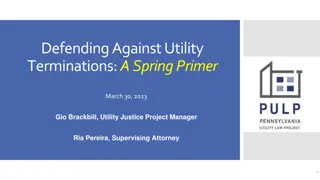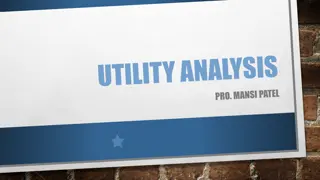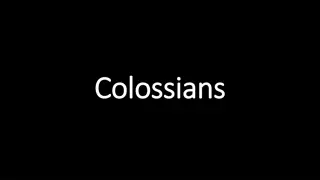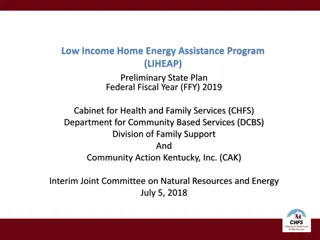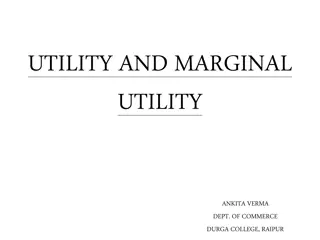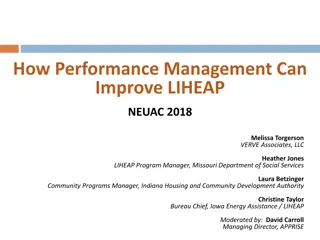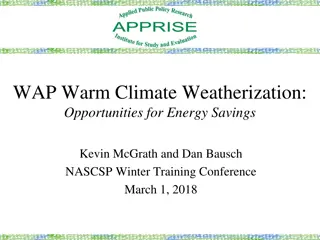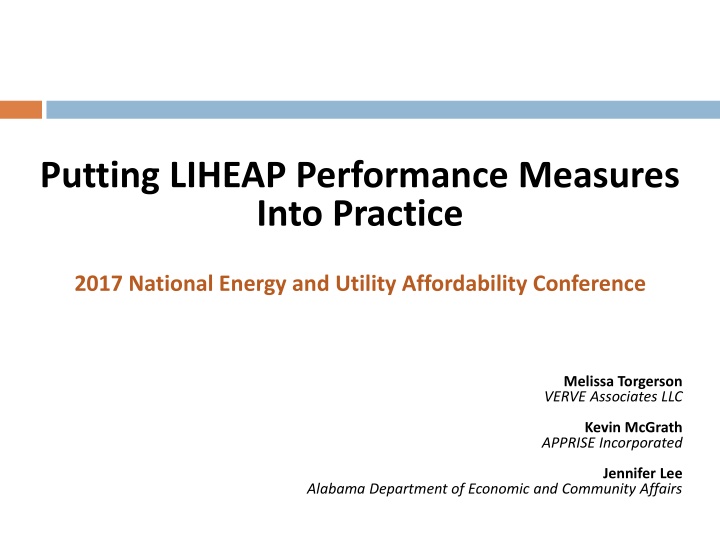
Putting LIHEAP Performance Measures into Practice: National Energy and Utility Affordability Conference
This content discusses the implementation timeline, data types, program analysis, and ongoing efforts related to LIHEAP Performance Measures. It also covers the background, statutory roots, development timeline, and current status of LIHEAP Performance Management. Through images and text, it provides insights into the progress made by grantees in utilizing data effectively for Performance Management.
Download Presentation

Please find below an Image/Link to download the presentation.
The content on the website is provided AS IS for your information and personal use only. It may not be sold, licensed, or shared on other websites without obtaining consent from the author. If you encounter any issues during the download, it is possible that the publisher has removed the file from their server.
You are allowed to download the files provided on this website for personal or commercial use, subject to the condition that they are used lawfully. All files are the property of their respective owners.
The content on the website is provided AS IS for your information and personal use only. It may not be sold, licensed, or shared on other websites without obtaining consent from the author.
E N D
Presentation Transcript
Putting LIHEAP Performance Measures Into Practice 2017 National Energy and Utility Affordability Conference Melissa Torgerson VERVE Associates LLC Kevin McGrath APPRISE Incorporated Jennifer Lee Alabama Department of Economic and Community Affairs
Putting LIHEAP Performance Measures into Practice Session Objectives 2 By the end of this workshop, attendees will have a better understanding of: The LIHEAP Performance Management implementation timeline, including progress to date. The types of data and information states are gleaning from LIHEAP Performance Measures. The ways LIHEAP grantees are using data to analyze and make decisions about their programs. Ongoing efforts to improve collection, reporting, and use of data for Performance Management among grantees (and their partners). Where to find additional resources related to LIHEAP Performance Management.
Putting LIHEAP Performance Measures into Practice Background 3 Both the development and design of LIHEAP Performance Measures are rooted in the LIHEAP Statute: Section 2605(b) of the Low Income Home Energy Assistance Act of 1981 (42 U.S.C. 8624(b)) as amended by Sec. 311(b) of the Human Services Amendments of 1994 (Public Law 103-252) requiring HHS to develop, in consultation with LIHEAP grantees, model performance goals that measure the success of each State s LIHEAP activities. Section 2610(b)(2) of the Low Income Home Energy Assistance Act of 1981 (42 U.S.C. 8629(b)(2)) requiring that HHS annually report to Congress on the impact LIHEAP is making on recipient and income eligible households. Section 2605(b)(5) of the Low Income Home Energy Assistance Act of 1981 (42 U.S. C. 8624(b)(5)) requiring LIHEAP grantees to provide, in a timely manner, that the highest level of energy assistance will be furnished to those households that have the lowest incomes and the highest energy costs or needs in relation to income, taking into account family size.
Putting LIHEAP Performance Measures into Practice Background 4 LIHEAP Performance Measurement Timeline 2008- 2010 Performance Management Work Group (PMWG) develops Performance Measurement Recommendations. 2010- 2012 Performance Management Implementation Work Group (PMIWG) transforms PMWG recommendations into Performance Measures. 2012- 2014 Development of OLDC and Performance Measurement Website. OMB Approves PMIWG recommendations. 2014- 2016 PMIWG works with OCS and APPRISE Team on guidance and support. Grantees work on building systems to collect and report new data. Grantees required to report LIHEAP Performance Measures data for FY 2016. Grantees start using data for Performance Management. 2017
Putting LIHEAP Performance Measures into Practice Background 5 As of June 2017: 42 grantees submitted Performance Management data for FY 2016. Many grantees are actively working with vendors to increase the amount of data included in their Performance Data Forms. APPRISE will continue providing training and technical assistance to improve the quantity, accuracy, and reliability of data for FY 2017 LIHEAP reporting.
Putting LIHEAP Performance Measures into Practice Background 6 From Performance Measures to Performance Management Summer 2013 Performance Management Website Published for Grantees Fall 2014 OMB Approval of LIHEAP Performance Measures Summer 2015 PMIWG Launches LIHEAP Virtual Library and Data Warehouse Advanced Search Initiatives Winter 2016 Publication of LIHEAP Virtual Library and Data Warehouse Advanced Search Capabilities Spring 2016 Regional Training on Performance Management Techniques Summer 2016 NEUAC Presentation on FY 2015 Performance Measures Reports Winter 2017 Performance Management Website Goes Public Spring 2017 T&TA on Using LIHEAP Performance Management Data Reported by Grantees FY 2018 LIHEAP Model Plans Designed by Grantees with Performance Management in Mind
Putting LIHEAP Performance Measures into Practice Session Overview 7 During the remainder of this session: Kevin McGrath(APPRISE) will highlight some results from FY 2016 LIHEAP Performance Measure data, and discuss where states are going in terms of using their data for performance management. Jennifer Lee (Alabama Department of Economic and Community Affairs) will share Alabama s experience with collecting, reporting, and using LIHEAP Performance Measure data for performance management. We will conclude the session by reviewing some of the steps being taken to increase the use of Performance Measures data in LIHEAP performance management.
Putting LIHEAP Performance Measures into Practice 8 What have we learned from Performance Measures Data reported for FY 2016? Kevin McGrath APPRISE Incorporated
Presentation Outline 9 1. Overview of reporting for FY 2016 2. Examples of reported data for FY 2016 3. How grantees are using the data 4. Tools and resources available to help grantees get there
Overview of reporting for FY 2016 10 Reporting Results (as of 6/20/2017) 42 / 51 grantees have submitted usable PM data for FY 2016 Even more on path to report for FY 2017 21 grantees have submitted final PM data for FY 2016 The reported data tell a lot of new information about their clients Income, bill, and burden differences across groups Data collected helping grantees understand effectiveness of benefit determination procedures
Overview of reporting for FY 2016 11 Reporting Challenges 7 states unable to report baseload electric data Can examine main heating fuel burden, but not total energy burden Important because many delivered fuel clients use supplemental electric heat, and because cooling (part of home energy) is an electric use 9 states unable to report complete delivered fuel data Incomplete analysis of clients across heating fuel types 7 states with high prevalence of zero income households Average income < average total energy bill; difficult to interpret outcomes
Examples of reported data for FY 2016: Prevention/Restoration Measures 12 Don t forget the little guy (at the end of the report)! A lot of attention paid to energy burden targeting measures BUT Prevention/restoration measures tell a lot about impact of program Questions to examine: Does the program effectively prevent home energy service loss? Are there policy decisions to keep in mind? Are there differences across fuel type? Are there external factors to consider?
Examples of reported data for FY 2016: Prevention/Restoration Measures 13 Example: Minnesota, Prevention/Restoration Due to Bill Payment Issues Focus on preventing service loss Some variation by fuel type, but aligned with expectations and external factors Shutoff rules for utilities Nature of delivered fuel use
Examples of reported data for FY 2016: Prevention/Restoration Measures 14 Example: Minnesota, Prevention/Restoration Due Energy Equipment Issues Focus on restoring service loss Policy decision made to focus on repairing/replacing inoperable equipment
Examples of reported data for FY 2016: Energy Burden Targeting Measures 15 Remember, it s not just about the targeting indexes! Performance Data Form gives you a lot more information: Average income, bills (heating, baseload electric, total), total benefits, and burden (pre/post) Average households, high burden households Across fuel types Start by understanding these data, then examine the indexes
Examples of reported data for FY 2016: Energy Burden Targeting Measures 16 Example: Wisconsin, Comparing Average Recipients to High Burden Recipients
Examples of reported data for FY 2016: Energy Burden Targeting Measures 17 Example: Wisconsin, Comparing Average Recipients to High Burden Recipients
Examples of reported data for FY 2016: Energy Burden Targeting Measures 18 Example: Wisconsin, Comparing Average Recipients to High Burden Recipients
Examples of reported data for FY 2016: Energy Burden Targeting Measures 19 Example: Wisconsin, Average Households, Income & Bills Across Fuel Type
Examples of reported data for FY 2016: Energy Burden Targeting Measures 20 Example: Wisconsin, Pre-LIHEAP Burden & Benefits Across Fuel Type
Examples of reported data for FY 2016: Energy Burden Targeting Measures 21 Example: Wisconsin, Targeting Index Results Benefit Targeting Index Score of 145 = 45 percent higher benefit to high burden households than average households Burden Reduction Targeting Index Score of 114 = 14 percent greater share of energy burden covered/bill paid for high burden households than average households
Examples of reported data for FY 2016: Energy Burden Targeting Measures 22 Example: Wisconsin, Pre/Post-LIHEAP Energy Burden
How grantees are using the data: Using data to update benefit matrixes 23 Remember, these data are not just for purposes of reporting. They are useful to your program! For example, how might you use these data to examine benefit determination procedures? Q: Does the variation by fuel type in benefit matrix make sense? R: Use the Performance Data Form to check current assumptions and consider changes, if necessary
How grantees are using the data: Using data to update benefit matrixes 24 Example: Iowa V. ENERGY BURDEN TARGETING FY 2017 LIHEAP PAYMENT MATRIX* Bill Payment-Assisted Household Main Fuel FUEL TYPE POINTS Electricity Natural Gas Propane B. All Households with 12 Consecutive Months of Bill Data (Main Fuel and Electric) Natural Gas 4 1. Unduplicated Number of Households with 12 Consecutive Months of Bill Data (Main Fuel and Electric) 9,416 32,761 370 Electric 4 $13,118 $16,328 $16,692 2. Average Annual Household Income Liquid Petroleum 5 3. Average Annual Total LIHEAP Benefit per Household (including Heating, Cooling, Crisis, Supplemental Benefits) 4. Average Annual Main Heating Fuel Bill 5. Average Annual Electricity Bill 6. Average Annual Total Residential Energy Bill Fuel Oil 5 $403 $465 $538 Wood/Coal/Corn 2 $1,194 $538 $857 *Just shows the fuel type component, not income or other factors $0 $1,173 $1,324 $1,194 $1,711 $2,181
How grantees are using the data: Using data to update benefit matrixes 25 Example: Iowa Previous slide shows one that Iowa may have some issues with their benefit matrix Electric Main Heat Benefit is 34% of Total Expenditures ($403 / $1,194) Natural Gas Main Heat Benefit is 27% of Total Expenditures ($465 / $1,711) Propane Main Heat Benefit is 25% of Total Expenditures ($538 / $2,181) This is NOT the only way to think about benefits. But, it is one way.
How grantees are using the data: Using data to update benefit matrixes 26 Example: Iowa Currently, benefit matrix assigns additive points based on fuel type. Alternative approach would be to develop fuel type adjustment factors and multiply the points assigned based on income: Electric main heat adj. factor = $1,194 / $1,194 = 1.0 Natural gas main heat adj. factor = $1,711 / $1,194 = 1.4 Propane main heat adj. factor = $2,181 / $1,194 = 1.8
How grantees are using the data: Using data to update benefit matrixes 27 Example: Iowa Just using <=75% HHSPG as income level & points for fuel type: Income = 8 points Fuel type (current is additive with income points; alternative is multiplicative) Electric: current = 4 points; alternative = 1.0 points Natural Gas: current = 4 points; alternative = 1.4 points Propane: current = 5 points; alternative = 1.8 points $50 per point Main Heating Fuel Benefits Using Current Proc. Benefit Using Alternative Proc. Group Ave. Total Energy Bill Electric $600 $400 $1,194 Natural Gas $600 $560 $1,711 Propane $650 $720 $2,181
How grantees are using the data: Looking beyond the benefit matrix 28 Example: Mississippi Reviewed their benefit matrix, which is designed to provide the highest benefits to: Lowest income, adjusted for household size (good!) Highest priced fuels (good!) But the Performance Measures data did not demonstrate this variation to the extent expected. Why? Looked beyond the matrix to program delivery: Clients receive benefits according to the bill amount presented at application Clients who come for assistance once during year are unlikely to receive the maximum benefit Change in program delivery may improve index scores
How grantees are using the data: Total residential energy or main heating analysis? 29 Example: Alaska For reporting, grantees are to report both the average main heating fuel bill & baseload electric bill by fuel type Targeting index scores are calculated using total residential energy bill But, many states design their benefit matrixes factoring in just heating costs In these cases, it s perfectly reasonable to examine main heating fuel burden (in addition to total energy burden completed for reporting) Is the program effectively targeting main heating fuel burden? Does it also target total energy burden? Do the data indicate that non-electric heaters might be using supplemental heating sources? Should the benefit matrix account for this?
How grantees are using the data: Total residential energy or main heating analysis? 30 Example: Alaska Analysis of Total Residential Energy Bill Analysis of Main Heating Fuel Bill The average household had a total energy bill = $3,113. LIHEAP helped pay $1,236 of that bill, leaving $1,877 to be paid by the average household and other sources. The average household had a main heat bill = $1,524. LIHEAP helped pay $1,236 of that bill, leaving $288 to be paid by the average household and other sources.
How grantees are using the data: Total residential energy or main heating analysis? 31 Example: Alaska Analysis of Main Heating Fuel Burden Analysis of Total Residential Energy Burden Before receiving LIHEAP, the average household had a total residential energy burden of 15.5%. After LIHEAP, it was 9.4%. Before receiving LIHEAP, the average household had a main heating fuel burden of 7.6%. After LIHEAP, it was 1.4%.
How grantees are using the data: Combined impact of LIHEAP + other EA programs 32 The reported Performance Measures data are specific to LIHEAP. However, many grantees have ratepayer and other energy assistance programs that are combined with LIHEAP or operate in tandem. And, many of these grantees have IT systems that allow for combined analysis of LIHEAP plus other energy assistance programs. For a more complete picture of energy burden faced by recipients, grantees might want to examine the Performance Measures by combining their LIHEAP program data with other program data. APPRISE will be looking into this topic in the near future.
Tools & resources available 33 Over the past few years, many resources have been developed by the PMIWG, APPRISE, and others to assist grantees in completing and understanding their Performance Measures data, including (links at end of presentation slides): LIHEAP Performance Management Website, including the Data Warehouse LIHEAP Virtual Library Training webinars National training presentations and curriculum Performance Management Integration Guide Other resources We strongly encourage you to use these resources and, if there s something missing, let us know. APPRISE is available to assist grantees examine special issues or topics unique to your state.
Putting LIHEAP Performance Measures into Practice 34 Moving Forward
Putting LIHEAP Performance Measures into Practice Building Upon What We ve Learned 35 LIHEAP Grantees, the Performance Management Implementation Work Group (PMIWG), OCS, and APPRISE have maintained a consistent feedback loop via conference calls, site visits, webinars, and training sessions. APPRISE is continuing to work with grantees to improve the quantity and quality of their Performance Measure data. The PMIWG and APPRISE are working with grantees to better understand and analyze data in context of program design differences.
Putting LIHEAP Performance Measures into Practice Emphasis on Performance Management 36 This Spring, APPRISE offered two webinars, as well as a three part national training workshop, focused on using LIHEAP data for Performance Management. The PMIWG is actively working on tools (like the Performance Management Integration Guide) to help grantees better understand their data, and use it to consider potential changes to their programs. Grantees are actively engaging partners (subgrantees and vendors) to review data and incorporate LIHEAP findings into program and policy discussions.
Putting LIHEAP Performance Measures into Practice Tools and Resources 37 Tools and Resources LIHEAP Performance Management Website https://liheappm.acf.hhs.gov/ Includes grantee resources, data warehouse, and reporting tools. Also includes newsletters and updates from the Performance Management Implementation Work Group. LIHEAP Virtual Library https://liheappm.acf.hhs.gov/assessment/#nbb Provides an easy to use interface that guides grantees to resources associated with different areas of program administration.
Putting LIHEAP Performance Measures into Practice Tools and Resources 38 LIHEAP Clearinghouse https://liheapch.acf.hhs.gov/stateplans.htm Contains state model plans, state program manuals, and descriptions of various state program components. ACF Training Resources Website https://www.acf.hhs.gov/ocs/resource/liheap-trainings Archived webinars, regional training, and national training sessions. Individual Training and Technical Assistance melissa@verveassociates.net, Kevin-McGrath@appriseinc.org APPRISE will work with grantees to assist with data collection, reporting, vendor data exchanges, IT systems, and more.
Putting LIHEAP Performance Measures into Practice Contact Information 39 Melissa Torgerson melissa@verveassociates.net 503-706-2647 Kevin McGrath Kevin-McGrath@appriseinc.org 609-252-2081 Jennifer Lee Jennifer.Lee@adeca.alabama.gov 334-353-3005




